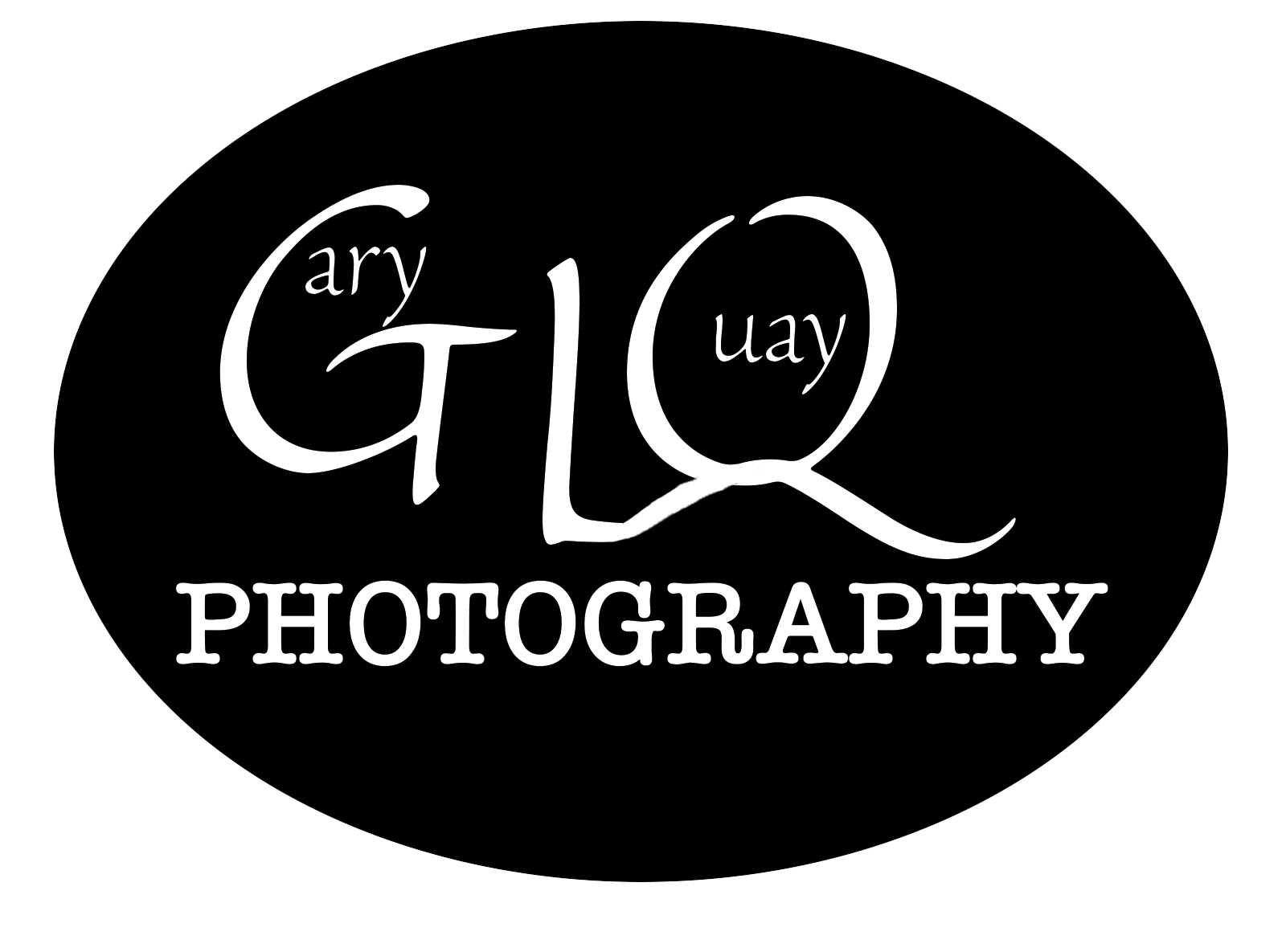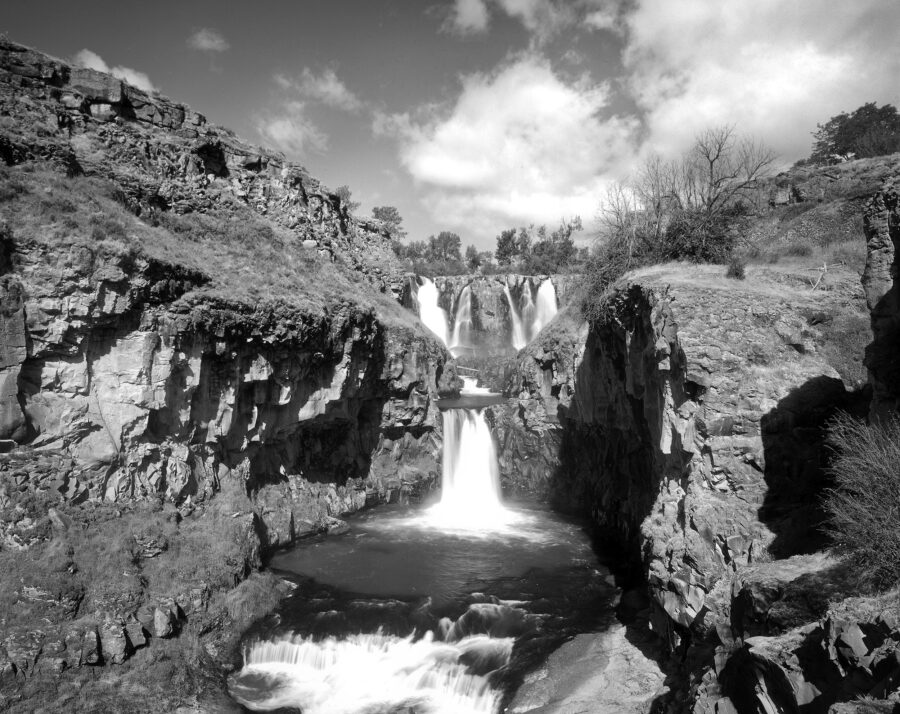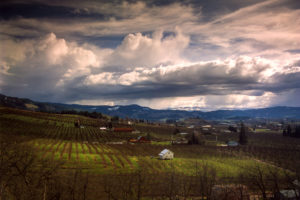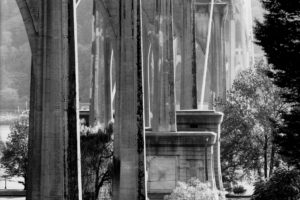When entering The Catacombs, carry the right kind of wine.
The Vault (or catacombs) is my euphemism for my older work. I keep my negatives in protective sheets in 3-ring binders labeled by the type of film, and the number of the binder. The picture above is from B&W MF # 1. “MF” stands for Medium Format, silly. While excavating, I will present very little work from before 1998 when I bought my Hasselblad. I was learning how not to take bad pictures before then, but my education was incomplete (actually, it still is). Maybe a few are pretty good ones before the ‘Blad days, but being self taught means learning composition in a haphazard manner. I read magazines like Outdoor Photographer, and Peterson’s Photo Graphic, American Photographer, and Popular Photography. They helped, but nothing motivates improvement like paying for a roll of film, paying for the trip to use it, and then for the developing and printing, only to be completely underwhelmed by the results.

©1999 Gary L. Quay
This is one of my earlier images on Infrared Film. I like the convergence of the living tree and the dead one. We had some fluffy clouds in the background to top it off.
For some reason, it does not translate very well to the internet. The leaves are a lot brighter that they appear here. I will have to work on it some more, but this one will do for now.
Camera: Hasselblad 500CM
Lens: 80mm Zeiss Planar
Film: Konica IR 750

©2007 Gary L. Quay
Early on in my large format tribulations, I hiked up to the top of Wahkeena Falls, and followed the stream almost to Fairy Falls. I took this picture on the way.
Camera: Linhof Technika
Lens: 150mm Linhof
Film: Kodak TMax 400

©2011 Gary L. Quay
The wind was so strong that I eventually gave up on the tripod, and hand held everything. I had brought the hasselblad as a last-minute decision, intending to use only large format. I’m glad I did, because I would have gone home empty handed otherwise.
Up on Rowena Crest, the wind was even stronger. We eventually gave up, because we feared that we may have lost equipment over the edge.
Camera: Hasselblad 500CM, hand held at 125th sec.
Lens: 50mm Carl Zeiss.
Film: Kodak T-Max 400 Developed in Kodak Xtol.

©2011 Gary L. Quay
This is the Bingen Gap in the Columbia River as seen from a viewpoint on the Historic Columbia River Highway at Mosier, Oregon.
Camera: Hasselblad 500CM hand held at 125th sec.
Lens: 50mm Carl Zeiss.
Film: Kodak TMax 100 developed in Kodak Xtol.

©2011 Gary L. Quay
A happy accident of a sort. I put the wrong film holder in the camera. I had meant to shoot Kodak Portra 160VC, and shot some Arista.edu 100 instead. With no contrast filter, I was worried that It would be drab, but the extra half stop of exposure (between 100 speed and 160) and using Rodinal at 1:50 at an N+1 expansion corrected for this a little at the expense of some detail in the blossoms. Not that I would have gotten much detail there anyway, the wind never let up long enough for me to both stop motion and have decent depth of field.
Something I hadn’t noticed at the time was the way the lamp post on the right seems to lean. I used a wide angle, and I should have corrected the convergence with a little back tilt. Live and learn.
Camera: Sinar Alpina 4×5.
Lens: 90mm Nikkor.
Film: Arista.edu 100 developed in Agfa Rodinal 1:50.

©2009 Gary L. Quay
Portland, Oregon from Vista Blvd, April 2009. It was part of the Night Shift Project.
Spring had almost sprung. I drove my aging Volvo into the West Hills high above Portland, and erected my tripod just up the road from the Vista Bridge. As was the case many nights before, my day job working on the night shift was keeping me awake on my days off. This is one result.
I had a habit of printing my printing my pictures too darkly. I tried to correct that on this one, while maintaining the intensity.
Camera: Deardorff 8×10
Lens: 19″ Goerz APO Artar
Film: Ilford HP5 Developed in Ilford Perceptol
Printed on Ilford MGIV RC

©2000 Gary L. Quay
I took this picture a long time ago on a visit to Victoria BC, and its surrounding scenery. I’m pretty sure it’s the Sooke River near the Sooke River Potholes Public Park. It is certainly a beautiful part of the Pacific Northwest.
Camera: Hasselblad 500CM.
Lens: 80mm Carl Zeiss.
Film: Ilford Pan-F +

©2005 Gary L. Quay
2005 marked the last production year for Konica IR 750 film. I was trying to use it sparingly. This is Wahkeena Falls in the Columbia Gorge, Oregon. Water is usually difficult to photograph in infrared, but can be easier when it runs down a shallow, cascade waterfall like his one.
Camera: Hasselblad 500CM
Lens: 80mm Zeiss Planar
Film: Konica IR 750.
Photographs can be a record of life, or a record of nature (among other things), but they are always a record of time. No moment is ever the same as the previous. The universe is in a state of flux. It is flexing, straining, expanding, mutating, evolving, living, dying, exploding, burning, and freezing. The state of the universe is appropriately described with verbs and adjectives. No moment is guaranteed, or can be predicted, except on a quantum, or biological level. The moment by moment flow of a waterfall under a canopy of trees is a tale of constant change. Being there to capture one of those moments is a supremely profound gift.
The photographic negative, while fragile, is a physical embodiment of the captured moment, unlike a painting which, unless painted from a photograph, is a collection of moments. Despite its fragility, the negative is more permanent than a pixel on a computer. As long as it exists, light can be shone through it to produce an image on paper.
Film Photography is a physical medium, and is best viewed on physical media. While the computer screen can convey an approximation of the picture, the negative printed on photographic paper by an experienced printer will always outshine the computer screen.

©1999 Gary L. Quay
Wahkeena Falls Trailside. Nature is unruly.
Camera: Hasselblad 500CM
Lens: 80mm Zeiss Planar
Film: Ilford FP4+
Some of the pictures here I have never displayed anywhere before. part of the fun has been going though my old negatives to see what I missed. Some negatives were less than pristine when I scanned them, but some turned out just fine. You won’t see the bad ones here, and that’s okay. I’m a tad picky.
Thanks for looking!
–Gary L. Quay




